
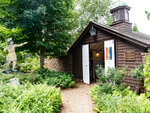

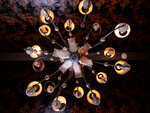
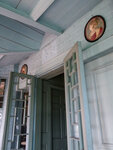
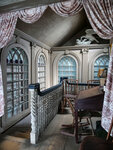
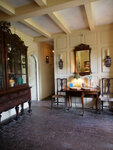
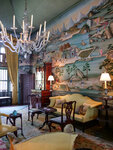
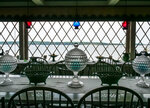
TUCKED DEEP INTO Eastern Point, behind a long brick wall on a spectacular and compact property overlooking Gloucester Harbor is something of a discovery, even for locals. It’s a winding, 40-room stone, clapboard and stucco home that has been a showcase and inspiration to many of America’s most recognized home decorators.
We’re describing, of course, Beauport, the Sleeper-McCann House, Historic New England’s property that has been open on a limited basis to groups of four or less since mid-summer for museum tours. The socially distanced tours are 45 minutes long, led by a museum docent, and advanced reservations are required. It offers an example of one of the few silver linings of COVID-19. Museums that have managed to stay open to the public offer intimate, incredibly special experiences that may never happen again once life returns to its regular pace.
“We made an assessment of which properties were suited for safe access to the public, and the Beauport Sleeper-McCann House was one of them,” said Martha Van Koevering of Historic New England and site manager of the museum. “We found with a little creativity, we could continue on a limited basis but make it really special.”
And special is. Besides offering regular tours, Historic New England opened Beauport this summer to rent for small, outdoor gatherings in one of the property’s cloistered gardens or waterside courtyard. (Other museums, like Magnolia’s Hammond Castle, did the same). The organization also adjusted its highly popular “Nooks and Crannies” tour that offers extended, deeper versions of normal tours at Beauport. Van Koevering said the museum scaled down the tour both size and length, and scheduled one in August and a second just this week. Both sold out quickly. No wonder. They offer a private experience that feels like the museum was closed “just for you.” As with regular tours, all specialty programs require online reservations ahead, and participants must adhere to safety protocols associated with CDC guidelines.
With all these details on programming, we wouldn’t want to miss sharing details on why the Beauport, the Sleeper-McCann House, a museum since 1942 and one of only two National Historic Landmarks in Gloucester, is so special. Henry Davis Sleeper, known as Harry, was born in Boston in 1878, the youngest son of a wealthy family. His real estate trust provided Sleeper with income to collect art, and financed the beginning of Beauport, his summer home built in 1907 to be near friends.
Sleeper’s interest in design started locally, and deeply. He was director of museums for the Society for the Preservation of New England Antiquities, (now Historic New England), and a founding member of the Shirley-Eustis House Association. In 1914 and 1915 he assisted in the reconstruction of the Our Lady of Good Voyage Church in Gloucester.
As Sleeper’s professional career as an interior designer and decorator grew, it brought Beauport attention from the media, friends, and eventually clients. Sleeper was clearly one of America’s earliest celebrity designers, and in nearly every way, his approach to design enthusiastically discarded expected (and rigid) methods of art collecting, architecture and design. He often purchased architectural remnants from razed estates or properties and reused them in projects, often where they don’t belong or weren’t intended. Beauport, for instance, has several interior doors that were originally grand, exterior entrance doors from other properties. Beauport also has no hallways anywhere. Sleeper didn’t like them.
Sleeper would break decorating rules in countless other ways, like drilling holes into dining or farm tables to permanently secure electrical lamps exactly where he deemed they belonged. He collected art and objects that he enjoyed, and grouped them together in ways that pleased him. Glass objects of all shapes are grouped against a back-lit window according to color (not age or manufacturer). And Sleeper felt free to pair a priceless object with an ordinary find he picked up antiquing at flea markets with his mother. In the “Octagon Dining Room,” which Sleeper dedicated to close friend Isabella Stuart Gardner, these collections are dramatically displayed against black walls, including a series of blood red tinware collected in Paris (which Sleeper wrote about in an update to Gardner) and amethyst colored glassware that greets guests at the room's entrance.
There are countless other examples of innovations and approaches to home décor that are still considered “modern” that were pioneered by Sleeper early in the 20th Century and on display at Beauport. Over nearly four decades, Sleeper expanded Beauport significantly, spooling out addition after addition to create a labyrinth-like show house for prospective clients to appreciate the spectrum of exhibits to his talent. One of Sleeper’s clients was the industrialist Henry Francis duPont, at the time one of America’s biggest art collectors. And in the 1930s, when a coffee company featured “surprisingly domestic well-known bachelors” like Gary Cooper and Richard Haliburton in a national ad campaign, it included Henry Davis Sleeper. Nearly one hundred years later, award-winning designers from around the world make the pilgrimage to Gloucester for inspiration.
Amazingly, the house is a perfect preservation of Sleeper’s professional ethos and private life. It’s like the whole property was dipped in amber. When Sleeper died with no heirs in 1934 from leukemia, interior design was hardly deemed an art form worthy of preservation. Thankfully it was purchased by Helena Woolworth McCann, wife of Charles E. F. McCann of Long Island and enthusiastic collector of European art and export porcelain. She understood the charm and historical significance of her new American find. McCann moved into the property, and kept it and its contents almost entirely intact, unchanged.
In fact, when Henry Francis duPont heard of the purchase, he wrote McCann congratulating her and offered his thoughts on the house.
“Naturally the minute you take the things out of this house, or change them about, the value of the collection does not exist,” he wrote her.
Indeed.